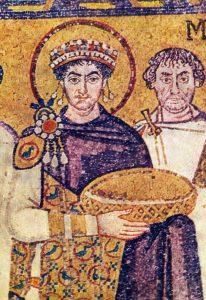THE ORIGIN OF ROYAL PURPLE

In Israel archaeologists discovered purple textile scraps from the times of King David and King Solomon, about 3000 years ago. In Hierapolis, modern day Pamukkale in Turkey, there is a sarcophagus with the inscription that reads: “The owner of the sarcophagus Publius Aelius Glykon Zeuxianos Aelianus left behind 200 denarii as grave–crowning funds to the most holy presidency of the purple–dyers”. Lydia, a seller of purple from the city of Thyatira (modern day Akhisar in western Turkey) is mentioned in Bible.
In 2003 a deposit of fragmented purple snail shells and well preserved purple dye workshops were discovered at the site of Andriake, the ancient port of the Lycian city of Myra in southern Turkey. This discovery gives an excellent opportunity to investigate the process of purple‐dye production in antiquity.
Phoenician King, Phoenix of Tyre, was the first ruler to wear Tyrian purple which was first produced in Phoenician city of Tyre in the Bronze Age. Phoenicians were famous as sellers of purple and exported its manufacture to its colonies. In the colkony of Cathage it became popular, and was adopted by Romans as a symbol of imperial status.

“Tyrian purple” came from a species of sea snails, and it was so rare that it became worth its weight in gold. Dye-makers had to crack the snail’s shell, extract a purple-producing mucus and expose it to sunlight for a certain amount of time. It took about 250,000 mollusks to produce just one ounce of usable dye, but the result was a vibrant and long-lasting shade of purple.
Some Roman emperors forbid their citizens from wearing purple clothing under penalty of death. Purple was especially revered in the Byzantine Empire. Its rulers wore purple robes and signed their edicts in purple ink, and their children were described as being “born in the purple.”
Eastern Roman Emperor Justinian, on January 18 of the year 532, was about to be overthrown and killed by rebel leader Hypatius. A fast galley waited at the palace’s harbor to take him and Empress Theodora to safety in Thrace. His advisers persuaded him that the rebellion could not be stopped and that the only solution was to escape. Just as Justinian was getting ready to leave, the empress rose from her throne and delivered a speech that kept her husband from taking flight and led to the slaughter of the rebels: “May I never be deprived of this purple robe, and may I never see the day when those who meet me do not call me empress. If you wish to save yourself, my lord, there is no difficulty. We are rick; over there is the sea, and yonder are the ships. Yet reflect for a moment whether, when you have once escaped to a place of security, you would not gladly exchange such safety for death. As for me, I agree with the adage that the royal purple is the noblest shroud”.
The royal class’ purple monopoly finally waned after the fall of the Byzantine empire in the 15th century, but the color didn’t become more widely available until the 1850s, when the first synthetic dyes hit the market.
If you would like to see read more of our similar articles, you can visit our facebook page:
https://www.facebook.com/turkeyprivatetoursephesus
